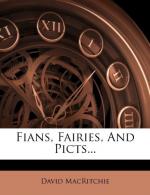It ought to be mentioned that the following paper was written for the Folk-Lore Society, at one of whose meetings (in February 1892) it was subsequently read. As, however, the Council of that Society ultimately decided that the paper was unsuited for publication in a journal devoted to the study of folk-lore, it now appears in a separate form. One advantage to be derived from this is that the illustrations which accompanied the lecture, and which are of much importance in enabling one to understand the argument, can also be reproduced at the same time. It may be added that, while the theme is capable of much amplification,[7] have preferred to print the paper as it was written for the occasion referred to. It states, concisely enough, the leading points of the argument.
To those who are interested in the “realistic” interpretation of such traditions, I beg to recommend for reference the following works:—First and foremost, there is “The Anatomy of a Pygmie,” by Dr. Edward Tyson (London, 1699), a book full of suggestive notices. This author has undoubtedly reached the “bed-rock” of the question; but, owing to his era and mental environment, he has not realised that his argument is useless without a consideration of the various stratifications above the “bed-rock.” Belonging to the same century is the chapter “Of Pigmies” in Sir Thomas Browne’s “Vulgar Errors,” wherein he makes several very interesting statements, although he argues from the opposite side. Scattered throughout the writings of Sir Walter Scott, both poetry and prose, there are also many references bearing upon this question, from the realistic point of view. In addition to these, there is his well-known treatise “On the Fairies of Popular Superstition,” prefaced to “The Tale of Tamlane,” wherein he states that “the most distinct account of the duergar [i.e. dwergs, or dwarfs], or elves, and their attributes, is to be found in a preface of Torfaeus to the history of Hrolf Kraka [Copenhagen, 1715], who cites a dissertation by Einar Gudmund, a learned native of Iceland. ‘I am firmly of opinion,’ says the Icelander, ’that these beings are creatures of God, consisting, like human beings, of a body and rational soul; that they are of different sexes, and capable of producing children, and subject to all human affections, as sleeping and waking, laughing and crying, poverty and wealth; and that they possess cattle and other effects, and are obnoxious to death, like other mortals.’ He proceeds to state that the females of this race are capable of procreating with mankind;[8] and gives




